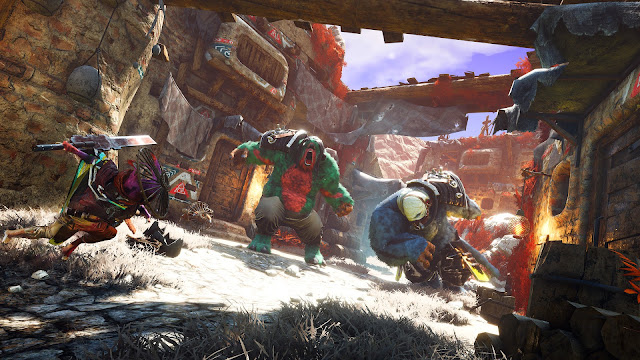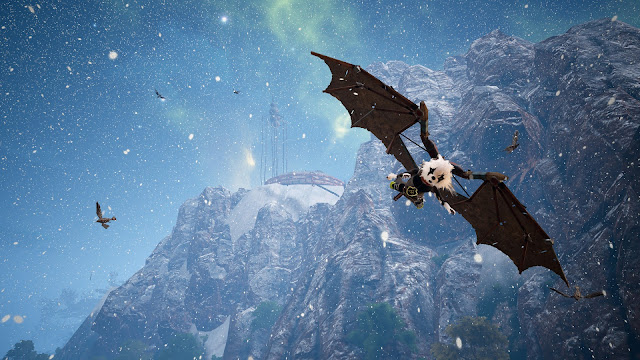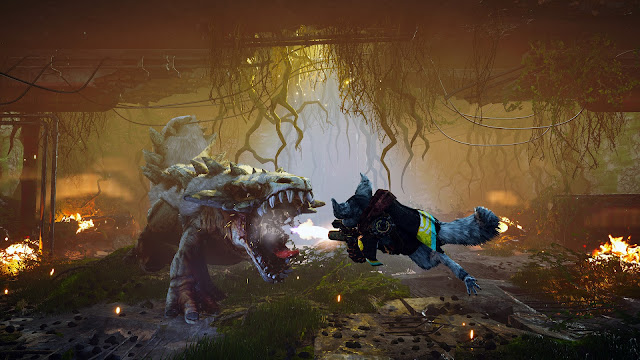Biomutant comes with an intriguing premise: in a post-apocalyptic world where humans are long-gone and mutant animals have taken their place, a martial art called Wung-Fu rules the day. The future of even this broken world hangs in the balance thanks to the dying Tree of Life, and six different tribes lead by six different Wung-Fu masters have different thoughts on the best path forward—adding tribal warfare to the already volatile state of things. As a young feline mutant with no memories of your past, you inevitably get wrapped up in this “Kung-Fu fable RPG” on a quest to save the world, one way or another.
There’s a lot of potential here, not least of all in the setup for a flashy, acrobatic combat system that blends martial arts, gunplay, and mutant powers—think John Woo or Devil May Cry with mutant cats and otters, and you’re on the right track. Such a concept should be a guaranteed hit, but it’s also one that’s difficult to get just right: combat needs to be smooth, fluid, and responsive enough to let those balletic movements flow together, and it’s not easy to get that finely-tuned enough for things to be able to click into place. Biomutant is a textbook example of what happens when the pieces don’t come together like they should.
Despite your character’s acrobatic prowess, movement in combat feels sluggish and hit detection feels inconsistent, making moving about and avoiding all the attacks coming your way—the cornerstone of this sort of action game—unwieldy and awkward. A dodge roll is one of your key moves, but with no invincibility frames and hitboxes that feel like they’re bigger than your actual character, trying to dodge an attack is as likely to get you hit as just standing there unless you anticipate it way in advance and get the hell out of the fight. The little icons that telegraph enemy attacks are easy to miss in a big brawl, and even if you do manage to successfully block and counter a strike, you’re locked into an attack animation that leaves you vulnerable to any other shots headed your way. When you’re fighting big groups, enemies have a tendency to attack unseen from off-screen, with no way to react and respond accordingly.
Best case, it means that you just weather any incoming damage, and unleash your biggest, flashiest combos all the same, counting on defeating your foes before they kill you. Worst case, what’s meant to be a stylish martial arts action game turns into an extremely conservative third-person shooter, with your distance and your trusty firearm being the most reliable way to keep your health bar intact as you take down your foes. For how much of a centrepiece combat is meant to be in Biomutant, it’s a shame that what’s here is so messy.
It’s also disappointing because of how much potential there is, especially when you get to the later parts of the game and start unlocking all sorts of new toys to play with. There’s a decent variety of weapon types to explore, from RPG- staple swords and clubs to quintessential kung-fu weapons like nunchaku and staff, and the ability to switch between them on the fly opens the door to plenty of flashy attacks. On top of that, mutant abilities and gadgets open the door to seemingly limitless possibilities. When you get strong enough that you don’t really have to worry about getting hit and can just let your creativity run rampant, combat becomes a lot more satisfying—still unwieldy, still messy, but with the freedom to just go nuts.
Some of the boss fights are especially memorable, 1notably the four “World Eaters” that threaten the Tree of Life and serve as one of the main objectives to carry you through the game. These colossal, set-piece battles combine the best parts of Biomutant’s freeform martial arts and more scripted encounters into something truly epic; there’s nothing quite like hopping into a giant mech to fight a huge lightning-eating monster in the rubble of an old apartment complex, before getting swallowed by it and fighting your way out of its stomach.
Where Biomutant absolutely delivers on its concept is in the design of its world. It’s a post-apocalyptic setting, with all the decrepit buildings and overgrown roads that come with it, but also with its own flourishes that make the world feel vibrant and unique. From Tibetan-inspired mountain villages to tropical lakeside paradises and lush rainforest areas, there’s as much beauty here as desolation—but also signs of the old world’s failures aplenty in oil-slicked wastelands and abandoned machinery with a capacity for destruction that’s baffling to the mutants who live here now.
It’s a fresh take on a familiar idea, which makes exploration consistently exciting. There’s plenty of loot to find, and materials for a surprisingly in-depth and open-ended crafting system that sees you combining different pieces of old-world tech to create new weapons and gear—not just “here’s a recipe to make a new sword”, but all sorts of different handles, blades, attachments, and the like that you can combine however you see fit. But exploration is more than just finding things you can use; this is also a world full of little details, interesting discoveries, and environmental storytelling that paints a vivid image of life before and after the end of the world.
It’s also a world that makes getting around enjoyable in its own right. Layered level design that makes great use of vertical space—both up and down, high-rise and underground bunker system, elaborate cliff networks and subterranean caves—keeps navigation interesting and makes a light puzzle of finding your way to your next destination. A wealth of different modes of transport, from the aforementioned mech to gliders and hot-air balloons, builds on the sense of discovery and exploration even further. Between the simple joy of moving through space and the sense of discovery baked into every piece of the environment, moving through Biomutant’s world is consistently engrossing.
The story that goes with this setting is a familiar one: the leftovers of a world that got so caught up in industrialisation and technological progress that it ended up destroying itself. But familiar as it is, Biomutant’s exploration of the environmental theme is an interesting one; the mutants’ curiosity about the world-that-was makes for a unique perspective, opening the door to some insightful commentary on the cost of climate change and environmental destruction. It’s a little on-the-nose, but that works here, and through its vision of a world post climate catastrophe, Biomutant makes a strong statement about the need for action.
It’s also a story full of quirky, oddball characters with unique perspectives on the world, and a decent dose of levity to balance out some of the heavier themes. Eccentricity seems to be the one thing that unites all the different tribes, and finding new settlements always comes with the joy of meeting some delightfully strange new folk. Different “Aura” alignments add another layer to your interactions, and even wind up influencing the state of the world, although it’s a far more clear-cut, black and white delineation than what’s initially suggested.
But with all these different characters and their stories and quest lines, pacing can be a struggle. This is true of any open-world game, but it’s especially apparent in Biomutant—even within the main quests, there are so many different stories unfolding at the same time, disjointedly smashed together. The question of your own character’s lost memories and the drawn-out flashback scenes only add to that, creating a game where seemingly minor details are laboured upon but major developments get glossed over in the blink of an eye.
It’s also a story that suffers thanks to a particularly annoying style of narration, where every character speaks a different language that then gets interpreted to you second-hand. While interesting in concept, it quickly loses steam when it means that every line of dialogue starts with “She said” or “He thinks”, and nothing ever gets done with the unique possibilities of a second-person narrative style. The acting itself is decent, but the script means that the narration quickly overstays its welcome.
Biomutant’s concept of a colourful post-apocalyptic kung-fu adventure is an intriguing one, and when all the pieces come together, it can be a riveting ride. The world is rich and exciting to explore, with plenty of hidden secrets to find and an important, convincing environmental message tied into it and a lot of freedom in how you build your character. But poor pacing holds back the narrative potential, and for all its open-endedness, a lack of finesse in the combat system leaves Biomutant feeling messy and awkward instead of hitting those stylish action high notes it’s shooting for.












